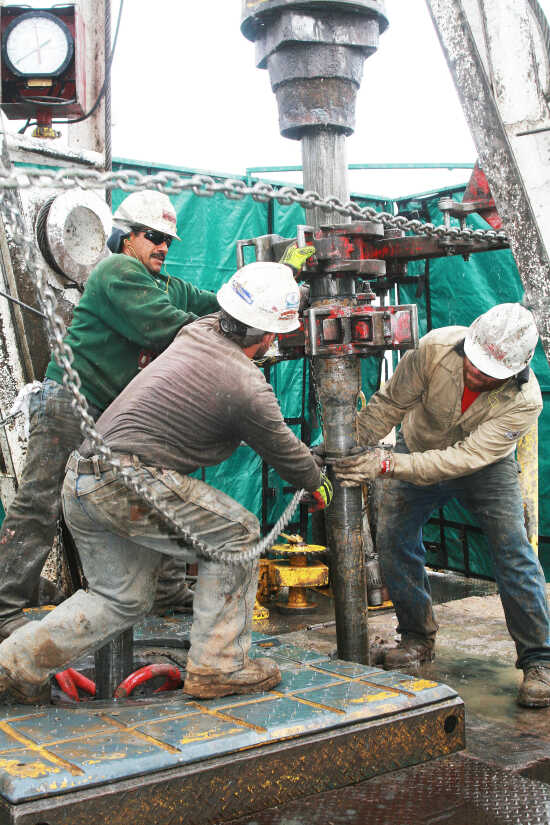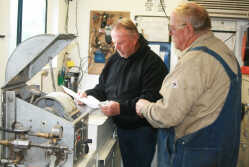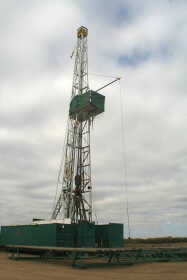3D technology helping find new oil wells in Southwest Nebraska

McCOOK, Nebraska -- Oil officials in Nebraska are crediting advancements in a technology called 3D seismic surveys for increased -- and highly successful -- oil drilling in southern Hitchcock and Dundy counties.
While there's been drilling and exploration for oil in the two counties for many years -- drillers found oil at Dry Creek northwest of Swanson Lake in 1963 -- this new drilling frenzy is unheard of in this area of Southwest Nebraska.
"What's changed, over the past four or five years, is the application of 3D seismic," Bill Sydow, director of the Nebraska Oil and Gas Conservation Commission in Sidney, said. Jim Gohl of Culbertson, a commissioner for NOGCC, said that 3D seismic is "a great tool" to help locate favorable drilling locations.

Gohl could name six companies that are drilling holes in the two counties in Nebraska, and on locations directly across the state line south in Kansas. Some of the resulting wells have been "very lucrative," he said, although he couldn't confirm rumors of individual wells pumping 700 to 800 barrels a day.
3d array
Sydow gets excited about the capabilities of and enhancements in seismic testing. He said that when seismic started, one dynamite charge (buried beneath the surface of the ground) sent vibrations down, they bounced off subsurface formations of rocks and up again, and a sensor called a 'geophone' made a single trace.

Sydow said that 2D seismic employed a line of geophones.
Now, Sydow said, 3D seismic means that a dense array of geophones records a subsurface "cube of data" from a grid pattern on the surface, and produces -- in conjunction with improved computer processing -- a much more detailed set of seismic information, including the "subtle highs" of stored oil and gas rather than just the indication of structural elements that may indicate oil/gas.
In Hitchcock and Dundy counties about three to four years ago, Sydow said, an acquisition company leased 40,000 to 45,000 acres and acquired a hundred square miles of 3D recordings using vibrators with steel plates mounted on a specially-designed truck chassis, rather than dynamite charges. "They drilled 10 wells, and got two or three decent wells," he said.

Then, two big-dog drilling companies, Berexco and Murfin, both of Wichita, Kansas, cooperated on what Sydow called "a joint venture," using one-pound dynamite charges to get their 3D information. They then drilled wells independently on their interpretations of the geology, Sydow said.
All using 3D seismic technology, Berexco and Murfin, Central Operating Inc. of Denver, Colorado, and Forestar Petroleum (formerly Credo Petroleum), of Denver and Austin, Texas, have become "very active in Hitchcock and Dundy counties. They've all made respectable discoveries, some 100-barrel-a-day wells," Sydow said.
Gohl said that other drillers punching holes in the same area are Kaler Co. of Hamlet, Nebraska, and Great Plains Energy Inc. of Lincoln.
Sydow said that wells in these two counties appear to be "capable of producing high volumes." Gohl called some "very lucrative."
Inexpensive leases
Gohl said that, unlike in Texas and Oklahoma, a drilling company "can lease a lot of acres and look at a lot of acres relatively inexpensively" in Southwest Nebraska, Northwest Kansas and Eastern Colorado.
Landowners/mineral rights owners are leasing their land for anywhere from $10 an acre up to, in very promising and/or proven areas, $275 an acre.
Border dispute?
Some of the Nebraska wells' close proximity to the Kansas border and drilling in that state is creating an issue because of a disparity in Nebraska and Kansas drilling rules and regulations, Sydow said.
In Nebraska, one well is allowed per 40 acres, and it must be located more than 500 feet from the boundary of that 40-acre plot.
Kansas, Sydow said, allows 10-acre spacing and 330 feet boundaries. In an area in Nebraska that allows two wells, the same area in Kansas can allow eight wells, he said.
A legal notice published in the McCook Gazette Oct. 10 indicates that Berexco is requesting that it be allowed to increase the density of wells in some southern Hitchcock County townships.
"This way we'll be able to protect our mineral interest owners from depletion by wells in Kansas," Sydow said.
This is the NOGCC's first emergency hearing to permit wells since 1995, Sydow said.
The hearing is Tuesday, Oct. 29, at 10 a.m. MT, in the NOGCC office in Sidney.
Limited tanker trucks
Another unforeseen -- but nice problem to have, yes? -- is the lack of enough tanker trucks to haul the oil away.
"We're limited by our own infrastructure," Sydow said.
The future
How long will these wells and fields last?
"The answer isn't simple," Sydow said. So much depends on the rock properties themselves, like porosity and permeability (porosity is the amount of void space in a rock; permeability refers to the degree to which these void spaces are interconnected and to how well a liquid flows through a material); the number of wells pumping and their pumping rate.
Sydow said these new wells will "decrease like a rock," because the permeability is so good, better than Sleepy Hollow." Sleepy Hollow is the oilfield southwest of Bartley discovered in 1960 and, Sydow said, "53 years later, Sleepy Hollow is still the fourth largest in daily production in Nebraska."
At some point in its production history, when production starts to drop off considerably, a field is "unitized" under one operator (in the case of wells in Hitchcock and Dundy counties, possibly Berexco or Murfin), for a water flood, or "secondary recovery," in which water is injected in wells and the water sweeps the oil toward producing wells where it and the water are pumped to the surface and separated. Proceeds from the produced oil are equitably distributed among mineral interest owners and work interest owners, Sydow said.
Like in Sleepy Hollow, which was unitized in the mid 1960s, Sydow said, "Keep moving water, it's (oil) going to be there."
Community benefits
An oil check every month is a great thing to have for mineral rights owners and/or landowners. It's a great supplement in an agricultural area whose economy is choked by drought.
But there are other benefits to oil activity that help more than those who now have a pumping unit -- or two, or more -- in their backyards.
Sydow said that the electrical infrastructure of an area is often driven by the oilfields, which now need electricity to run new pumping units. Farmers and livestock producers may now have electricity closer for their irrigation pumps and tank heaters, he said.
Another benefit, Sydow said, is that oil production can support property taxes and real estate taxes in a county. Oil production can add to a county's total valuation, making it possible for taxing entities to reduce their tax requests, or at least not increase them.
